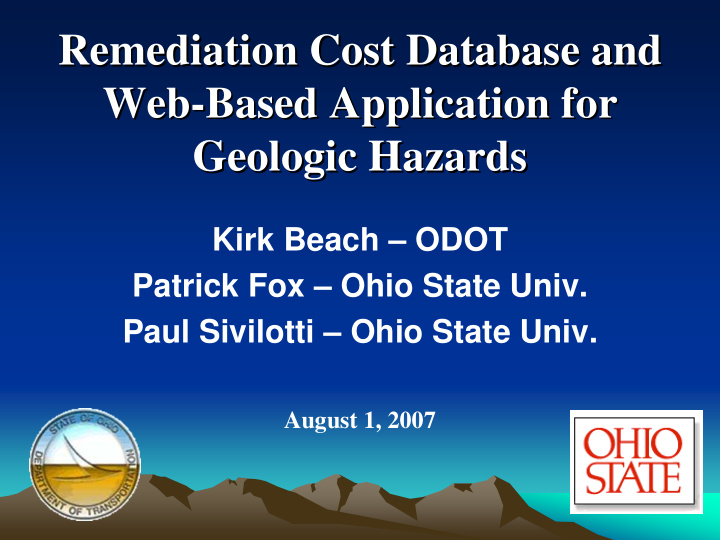



Remediation Cost Database and Remediation Cost Database and Web- -Based Application for Based Application for Web Geologic Hazards Geologic Hazards Kirk Beach – ODOT Patrick Fox – Ohio State Univ. Paul Sivilotti – Ohio State Univ. August 1, 2007
Geologic Hazard Types Geologic Hazard Types • Landslides • Rockfalls • Underground Mine Subsidence
Common Tasks Common Tasks • Creating a new sites, plans, and scenarios • Viewing itemized costs • Submitting plans for a site
Task: Creating a New Site Task: Creating a New Site
Remediation Techniques: Remediation Techniques: Landslides Landslides • Slope modification – Flatten slope, bench & re-grade, excavate & replace, counter berm, slope offloading • Drainage – Drainage pipes – Vertical drain trenches (parallel or perpendicular) • Soil modification – Over-excavate, modify, & reconstruct – Deep soil mixing – Chemical injection – Dynamic compaction • Retaining structures – Retaining wall (H-pile or sheet pile) – Drilled shafts • Retaining walls for road relocation or widening – Cantilever retaining wall, Mechanically stabilized earth retaining wall • User-defined
Primary Features of Primary Features of RCDA RCDA
Feature: Facilitates Cost Feature: Facilitates Cost Estimation Estimation • RCDA facilitates cost estimations for remediation – Input: site characteristics • e.g., elevation, soil type, angle of incline – Input: specifications for remediation • Choice of technique (e.g., excavate & fill) • Remediation parameters (e.g., grout hole spacing) – Output: • Itemized cost list for completing work
Feature: Facilitates Cost Feature: Facilitates Cost Estimation Estimation • RCDA also permits flexibility – User-defined remediation techniques – User-defined line items
Feature: Standardization Feature: Standardization • RCDA standardizes the cost estimation process across the Districts – Library of standardized remediation calculation methods – Standardizes costs based on state-wide averages • Unit costs for materials • Unit costs for drilling, excavation, disposal, etc • Mobilization overhead
Feature: Robustness Feature: Robustness • Site input data is checked for sensibility – e.g., Mine elevation must be below roadway • Remediation design is checked for sensibility – e.g., Minimum void width for stowing • As site data changes over time, remediation designs are re-checked for sensibility
Feature: Durability Feature: Durability • RCDA stores an audit trail – Archives kept of all submitted data used to calculate each cost estimate (e.g. unit costs) • Once plans are submitted, data can no longer be edited – Copies can be made for editing • When site data is revised, previous data is archived – Old remediation plans are archived as well
Feature: Accessibility Feature: Accessibility • RCDA is web-based and “browser neutral” – Accessible anywhere – Standard login / password authentication • User interface adopts some accessibility “best practices” for visually impaired users
Types of Data Stored in RCDA Types of Data Stored in RCDA Plan Scenario • Sites – Roadway locations Plan Scenario requiring remediation Site Scenario • Plans – Each site may have Plan Scenario several plans • Scenarios Plan Scenario – Each plan consists of Scenario one or more scenarios
List of Sites in Area List of Sites in Area
Searching Sites Searching Sites
Details Details Site Site
List of Site Plans
List Plan Scenarios List Plan Scenarios
Variables for Remediation Plan Variables for Remediation Plan
Task: Task: Viewing Itemized Costs Viewing Itemized Costs
Task: Submitting Plans Task: Submitting Plans
User Privilege Levels User Privilege Levels
Types of User Accounts Types of User Accounts • Two dimensions: – Area of authority (state, district, county) – Level of authority (admin, power, normal, guest)
Conclusions Conclusions The RCDA provides a consistent method and uniform cost database to calculate costs for remediation of: – Landslides – Subsidence of Underground Mines – Rockfalls Web-application allows ODOT Districts to submit remediation requests to ODOT Central Office. Better financial planning can be made on which hazards to remediate first.
Recommend
More recommend